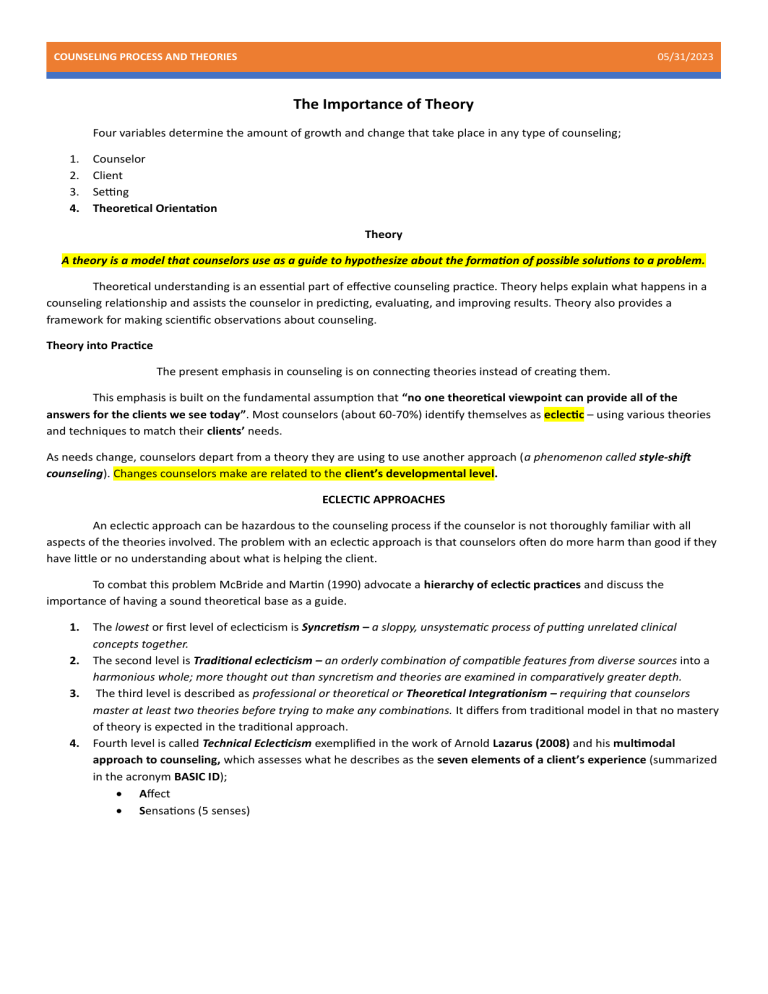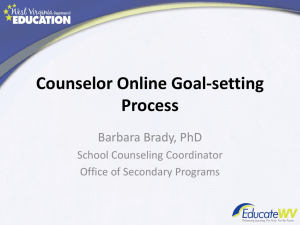
COUNSELING PROCESS AND THEORIES 05/31/2023 The Importance of Theory Four variables determine the amount of growth and change that take place in any type of counseling; 1. 2. 3. 4. Counselor Client Setting Theoretical Orientation Theory A theory is a model that counselors use as a guide to hypothesize about the formation of possible solutions to a problem. Theoretical understanding is an essential part of effective counseling practice. Theory helps explain what happens in a counseling relationship and assists the counselor in predicting, evaluating, and improving results. Theory also provides a framework for making scientific observations about counseling. Theory into Practice The present emphasis in counseling is on connecting theories instead of creating them. This emphasis is built on the fundamental assumption that “no one theoretical viewpoint can provide all of the answers for the clients we see today”. Most counselors (about 60-70%) identify themselves as eclectic – using various theories and techniques to match their clients’ needs. As needs change, counselors depart from a theory they are using to use another approach (a phenomenon called style-shift counseling). Changes counselors make are related to the client’s developmental level. ECLECTIC APPROACHES An eclectic approach can be hazardous to the counseling process if the counselor is not thoroughly familiar with all aspects of the theories involved. The problem with an eclectic approach is that counselors often do more harm than good if they have little or no understanding about what is helping the client. To combat this problem McBride and Martin (1990) advocate a hierarchy of eclectic practices and discuss the importance of having a sound theoretical base as a guide. 1. 2. 3. 4. The lowest or first level of eclecticism is Syncretism – a sloppy, unsystematic process of putting unrelated clinical concepts together. The second level is Traditional eclecticism – an orderly combination of compatible features from diverse sources into a harmonious whole; more thought out than syncretism and theories are examined in comparatively greater depth. The third level is described as professional or theoretical or Theoretical Integrationism – requiring that counselors master at least two theories before trying to make any combinations. It differs from traditional model in that no mastery of theory is expected in the traditional approach. Fourth level is called Technical Eclecticism exemplified in the work of Arnold Lazarus (2008) and his multimodal approach to counseling, which assesses what he describes as the seven elements of a client’s experience (summarized in the acronym BASIC ID); Affect Sensations (5 senses) Imagery Cognitions Interpersonal relationships Drugs (i.e., any concern about health, including drug use, diet, or fitness) In this approach, procedures/techniques from different theories are selected and used in treatment without necessarily subscribing to the theories that spawned them. 5. A final type of eclectic approach is the Transtheoretical Model (TTM) of Change – developmentally based and an alternate to technical eclecticism, direction focused in nature and proposes five levels of change; 1. symptom/situation problems, 2. maladaptive cognitions, 3. current interpersonal conflicts, 4. family system conflicts, and 5. intrapersonal conflicts. This approach allows for a more macroscopic approach and personal adaptation rather than simple personal adjustment. Now the first theoretical paradigm that we are going to study is; PSYCHOANALYTIC THEORIES WAIT! Meet _____________ (give him a nickname) You’ll see him whenever you need to be reminded of the difference between a psychotherapist and a counselor PSYCHOANALYSIS Founders/Developers: Sigmund Freud - then Anna Freud – most recent Heinz Kohut View of Human Nature: People have a conscious mind, a preconscious mind, and an unconscious mind. Personality consists of three parts i.e., id, ego, and superego. There are five stages of psychosexual development that focus on a zone of pleasure that is dominant at a particular time. Oral stage Anal stage Phallic stage Latency Genital stage Excessive frustration or overindulgence in the first three stages are the main difficulties that can arise going through these stages, in which case the person could become fixated at the level of development and/or overly dependent on the use of immature defense mechanisms. Role of the Counselor: Professionals practicing classical psychoanalysis function as experts – encourage clients to talk about whatever comes to mind (free association) especially childhood experiences. To create such an atmosphere where client feels free to express difficult thoughts, after few face-to-face sessions, often have the client lie down on a couch while the analyst remains out of view (usually seated behind the client’s head). Analyst’s role is to let the client gain insight by reliving and working through the unsolved past experiences. Development of transference is encouraged. Unlike some other approaches, psychoanalysis encourages the counselor to interpret for the client. Goals: Although varying according to client, psychoanalysis’ goals focus mainly on personal adjustment, usually inducing a reorganization of internal forces with the person. In most cases, a primary goal is to help the client become more aware of the unconscious aspects of his or her personality and to work through current reactions that may be dysfunctional. A second major goal, often tied to the first, is to help a client work through a developmental stage not previously resolved (fixation) which may require major reconstruction of the personality. A final goal of psychoanalysis is helping the clients cope with the demands of the society in which they live. The focus is on strengthening the ego. Techniques: Free Association: No censoring of thoughts, the id is requested to speak while the ego remains silent. Unconscious material enters the conscious mind and the counselor interprets it. Dream Analysis: “The royal road to unconscious” – Counselor sensitive to two aspects of dreams i.e., manifest content and latent content. Analyst helps interpret both aspects to the client. Analysis of Transference: Analyst encourage it and interprets the positive or negative feelings expressed. Analysis of Resistance: Resistance to therapeutic process may take many forms such as missing appointments, persisting in transference, blocking thoughts during free association, or refusing to recall dreams or early memories. Analysis of this resistance helps clients gain insight into it as well as other behaviors. Limitations: Time consuming and expensive – sessions usually occur 3-5 times a week over a period of years Mostly effective only on middle-aged people Getting extensive training in psychoanalysis is far more difficult than other interventions Vague concepts not easily communicated or understood (such as id, ego, superego) Deterministic in nature Mostly only effective and applicable on individuals with major adjustment difficulties who want to explore unconscious ADLERIAN THEORY Founders/Developers: Alfred Adler proposing Individual Psychology View of Human Nature: People are primarily motivated by social interest. Conscious aspects of behavior rather than unconscious are central to personality development. Most people are striving for perfection. Initially each person has tendency to feel inferior to other which, if isn’t resolved, leads to inferiority complex. Overcompensation of this feeling leads to superiority complex. Five ordinal positions (birth order) emphasized in Adlerian literature i.e., firstborns, secondborns, middle children, youngest children, and only children. Emphasized family environment and style of life; negative family atmosphere might be authoritarian, rejecting, suppressive, materialistic, overprotective, or pitying. Positive family atmosphere might be democratic, accepting, open, and social. Three main life tasks that humans have necessary for survival: society (contributing to society), work (being independent), and sexuality (defining it in regard to self and others). Role of the Counselor: function primarily as diagnosticians Goals: To help clients overcome a faulty style of life Techniques: Confrontation: Challenging client to challenge their own logical reasoning and see if its plausible or problematic. Asking “the question”: Asking “what would be different if your were well?” Encouragement: Encourage client to have faith in themselves and feel good about themselves and others. Acting “as if”: Acting as if they are the person they want to be – for instance, the ideal persons they see in their dreams. Spitting in the client’s soup: Counselor points out certain behaviors to clients and thus ruins the payoff for the behavior e.g. A mother who always acts up superior to her daughter may continue to do so after the behavior is pointed out but the pleasure (reward) she derived by doing so is now gone. Catching oneself: Clients learn to become aware of self-destructive behaviors. At first, counselor helps but later the responsibility falls solely on the client. Task setting: Client starts from attainable short-term goals and moves to long-term more complex goals Push button: Clients are taught that they hold the button for the type of emotion or feeling they want to experience whether positive or negative Limitations: Lacks firm research base Too optimistic about human nature/neglectful of many life dimensions Cultural difference in family structures ignored Relies heavily on verbal erudition (verbal wisdom), logic, and insight which limits applicability to intellectual clients BEHAVIORAL COUNSELING BEHAVIORAL THERAPY [Task for Class] Mention the founders: _____________________________________________________________________________________ What was their view of human nature? ________________________________________________________________________ Role of the Counselor: Counselor functions as a consultant, teacher, adviser, reinforcer, and facilitator. May even instruct or supervise support-people in client’s environment. What is their major goal? ____________________________________________________________________________________ Mention their major techniques: R_ _ _ _ _ _ _ _ _ t P________t S_____g G____________n E________n F______g A _ _ _ _ _ _ e Therapy I _ _ _ _ _ _ _ e Therapy Describe the following techniques Time-out: Systematic desensitization: Assertiveness Training: Contingency Contracts: Limitations: Only deals with explicit behavior, difficult to replicate in uncontrolled environment, ignores clients’ past history and unconscious forces, doesn’t consider the development stage much. COGNITIVE & COGNITIVE-BEHAVIORAL COUNSELING Cognitive theories are successful with clients who have the following characteristics; Average to above average intelligence Moderate to high levels of functional distress Able to identify thoughts and feelings Not psychotic or disabled by present problems Are willing and able to complete systematic homework assignments Possess a repertoire of behavioral skills and responses Process information on a visual and auditory level Frequently have inhibited mental functioning, such as depression Three theories fall under this paradigm; 1. 2. 3. Rational Emotive Behavioral Therapy Reality Therapy Cognitive Therapy RATIONAL EMOTIVE BEHAVIORAL THERAPY (REBT) Founders/Developers: Albert Ellis – this theory has similarities to Aaron Beck’s cognitive therapy and David Burn’s mood therapy. Maxie Maultsby also formulated a behavioral variation of REBT. View of Human Nature: “People are inherently rational and irrational, sensible and crazy” According to Ellis, rational beliefs are defined as beliefs that are flexible, non-extreme, and logical (i.e., consistent with reality), and in contrast, irrational beliefs are rigid, extreme, and illogical (i.e., inconsistent with reality). Ellis believes that people have within themselves means to control their thoughts, feelings, and actions, but they must first realize what they are telling themselves (self-talk) to gain command of their lives. Ellis believes that people should not rate themselves in terms of perfection (everyone is a fallible human being). Role of the Counselor: Active and direct -Instructors who teach and correct the client’s cognitions. “Countering a deeply ingrained belief requires more than logic. It requires consistent repetition.” Goals: Primary goal is to help people realize that they can live more rational and productive lives; and to help people change self-defeating thoughts and behavior. One way to achieve that is through teaching clients the A-B-C-D-E model of REBT; A. B. C. D. E. Affecting experience Belief – how the person thinks about the experience Consequence – emotional reaction to B Disputing irrational thoughts, usually with the help of a REBT counselor, and replacing them with; Effective thoughts Thoughts about experiences may be characterized in four ways: positive, negative, neutral, or mixed. Clients are taught to be more tolerant of self and others and encouraged to achieve personal goals. Techniques: Teaching Disputing Confrontation (challenge client who claims to be thinking rationally but in truth isn’t) Encouragement (encourage to abandon unhelpful thought processes) Teaching: Involves having clients learn the basic ideas of REBT and understand how thoughts are linked with emotions and behaviors. Teaching the primary ideas (see from goals) to the client is called rational emotive education (REE). Disputing: Disputing takes one of three forms: cognitive, imaginal and behavioral Cognitive Disputation involves the use of direct questions, logical reasoning and persuasion Imaginal Disputation uses client’s ability to imagine and employs a technique known as Rational Emotive Imagery [Rational Emotive Imagery: By telling yourself— strongly and repetitively—a sensible rational Belief (rB) or coping statement. For example: “Yes, they really did treat me shabbily and unfairly, which I wish they wouldn't have done. But there's no reason why they must treat me fairly, however preferable that would be] Behavioral Disputation involves behaving in a way that is the opposite of the client’s usual way, including role-playing and the completion of a homework assignment in which a client actually does activities previously thought impossible to do. Sometimes it may take the form of bibliotherapy. Limitations: Can’t be used with people having severe thought disorders (such as, schizophrenia) The approach’s emphasis on changing thinking may not be the simplest way of helping clients change their emotions. COGNITIVE THERAPY (CT) Founders/Developers: Aaron Beck – his daughter Judith Beck is a leading proponent of CT today. Both Beck and Ellis started their careers with psychoanalytic training but later parted their ways (they started developing their theories at about the same time for which their ideas hold similarities). View of Human Nature: Dysfunctional behavior is caused by dysfunctional thinking. If beliefs change, symptoms and behavior change. Role of the counselor: Active – works with client to make covert thoughts more overt. This process is especially important in examining cognitions that have become automatic such as, everybody thinks I’m boring. Goals: Excessive cognitive distortions, such as all-or-nothing thinking, negative prediction (assuming the worst outcome), overgeneralization (for example, failure at accomplishing one task will predict an endless pattern of defeat in all tasks), labeling of oneself, self-criticism, and personalization (i.e., taking an event unrelated to the individual and making it meaningful to oneself) such as; “It always rains when I want to play tennis” Similarly, counselors often work with clients on overcoming their lack of motivation. Techniques: Challenging the way individuals process information Countering mistaken belief systems Tackling cognitive distortions Doing self-monitoring exercises designed to stop negative automatic thoughts Improving communication skills Increasing positive self-statements (that now we call self-affirmations in regular terms) and exercises Doing homework including disputing irrational thoughts Limitations: Not the best approach for intellectually limited people Doesn’t work with resistant clients Not usually best for people seeking a more unstructed insight-oriented approach that does not require active participation of client in homework assignments HUMANISTIC THEORIES Unlike psychoanalytic theories’ deterministic nature, we know that humanistic theories are entirely inclined towards free will. The term humanistic focuses on individual’s potential to actively and freely decide about matters related to themselves and their environment. People are treated as decision makers and initiators of their own growth and development. Three theories under this paradigm will be covered in class; Person-centered counseling Existential counseling Gestalt therapy PERSON-CENTERED COUNSELING Founders/Developers: Carl Rogers View of Human Nature: “Humans are characteristically positive, forward-moving, constructive, realistic and trustworthy” Self-actualization and phenomenological perspective hold particular importance. The self is the outgrowth of what a person experiences and an awareness of self helps a person differ himself or herself from others. For a healthy self to emerge, a person needs positive regard (which better be unconditional). There should be no incongruencies between real and ideal self. The greater this incongruency is the more alienated and maladjusted a person becomes. Role of the counselor: Facilitator rather than a director – setting up and promoting a climate where a client is free and encouraged to explore all aspects of self. The client is entitled to direct his or her own therapy thus, the counselor trusts the client to develop an agenda on which he or she wishes to work. Goals: Helping a client become a fully functioning person who has no need to apply defense mechanisms to everyday experiences. Such an individual becomes increasingly willing to change and grow. Techniques: The quality of the counseling relationship is much more important than techniques. Three necessary and sufficient conditions of counseling: empathy unconditional positive regard deep and genuine caring for the client as a person – that is, prizing the person just for being. congruence (counselor’s genuineness, openness, authenticity, transparency) Empathy is a way to think with, rather than about or for the client. Subjective Empathy: enables a counselor to momentarily experience what it is like to be a client. Interpersonal Empathy: relates to understanding a client’s phenomenological experiencing in relation to others. Objective Empathy: uses reputable knowledge sources outside of a client’s frame of reference Limitations: Criticized for being too simplistic, optimistic, leisurely, and unfocused for clients in crisis or who need more structure and direction Depends on bright, insightful, hard-working clients for best results This approach ignores diagnosis, and only deals with surface issues because of its short-term nature The approach is more attitudinal than technique-based

